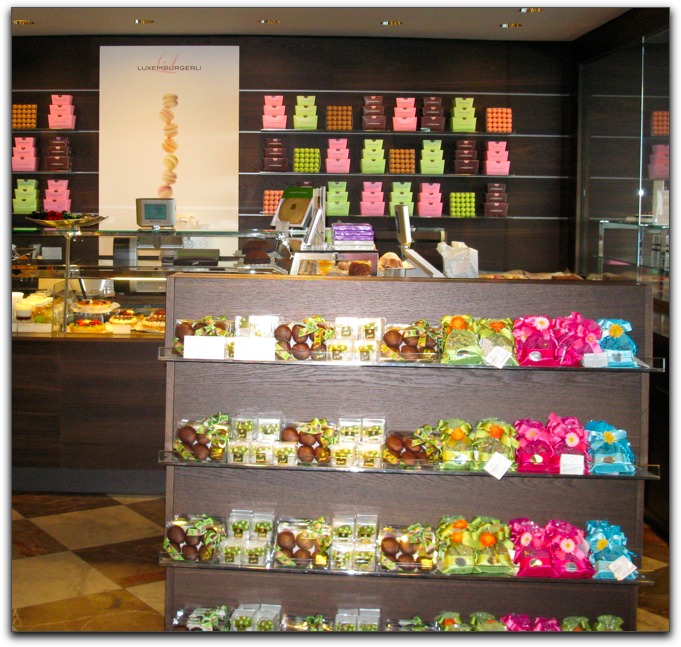
Rosh haShannah in Zurich (visits to two synagogues and the Dada café, and much more)
Even though we now had an all-day parking pass, Mark needed to rise and shine early enough to make sure it was in a blue area and put the permit in the car before the parking police came by. We dressed for Yontif and went out to find breakfast. Our first morning (Tuesday) we had noticed a small farmers’ market in the square (Helvetia Platz) near where “our” bancomat and parking space was. Each succeeding morning we hoped to see it again, to no avail. Across the street from that square is the Volkshaus, celebrating its 100th anniversary. We had noticed that it housed a restaurant and a bar/coffee shop. If at one time this was a “house of the people”, the prices have by now squeezed them out. We ate a healthy, if somewhat pricey breakfast, once again, al fresco, before our 10 minute/ half-mile walk to the synagogue.
This morning we were recognized without problem. We entered, picked up our Machzorim and sat in the row against the back wall.
One special feature of the Shofar service was the way R. Bar-Ephraim did the calls:
“Teki……yah…”
“Sheva’a’a’arim”
“Te[rolled:]rrrrrrrrrrrrru…ah”
Each call was made to sound as if it was the shofar itself being blown. There was nothing distracting about this, but rather, enhancing. It was almost as if the rabbi was “instructing” the ba’al shofar not simply the name of the next blast, but hinting at its melody.
The morning service had more than twice as many in attendance as the night before. As it turned out a few couples who sat near us were Swiss/American intermarriages. There are quite a few of them in the congregation. As the service progressed a couple of expats recognized us from the previous evening and sat beside us, so that, when services ended, we had people ready to engage us in conversation.
Following services we walked along the Schanzengraben, a moat that formed part of the medieval fortifications of Zurich. It now offers a lovely green strip from the Sihl river across to the Zurich sea. We made our way to Paredeplatz, stopping in at the very chic Confiserie Sprüngli

to pick up a sandwich and salad for lunch which we enjoyed on a park bench in the shade nearby.
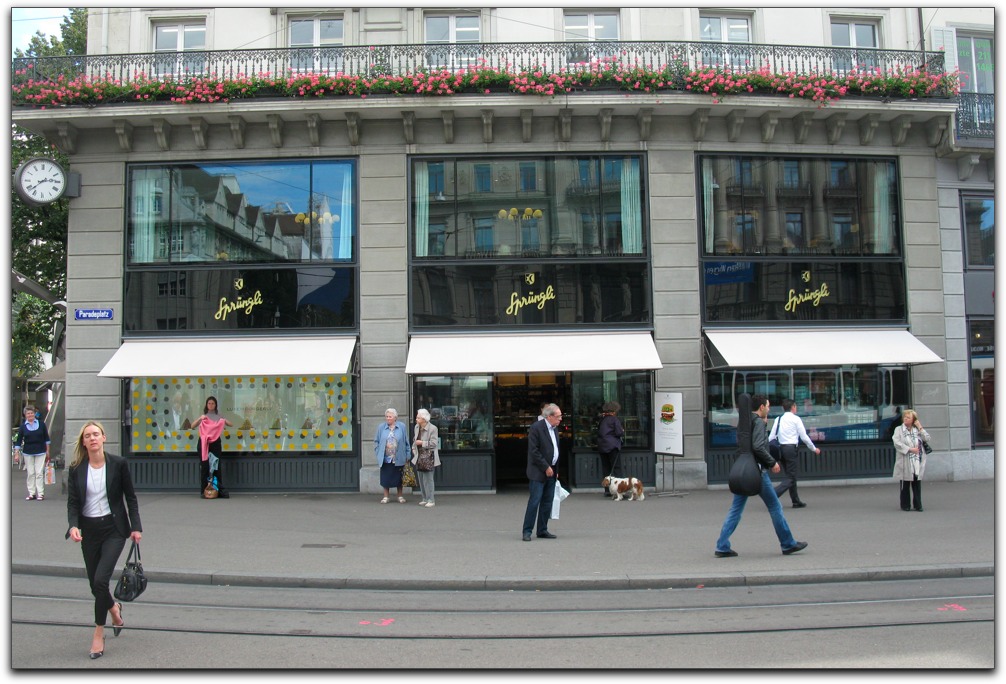
Continuing on our walk down the far end of the Bahnhoffstrasse (we had been at the top when we visited the Apple store) we came upon a gallery with an exhibit that reminded us of some work we had seen on Madison Ave, in New York City in early May of this year.
Madison Ave:
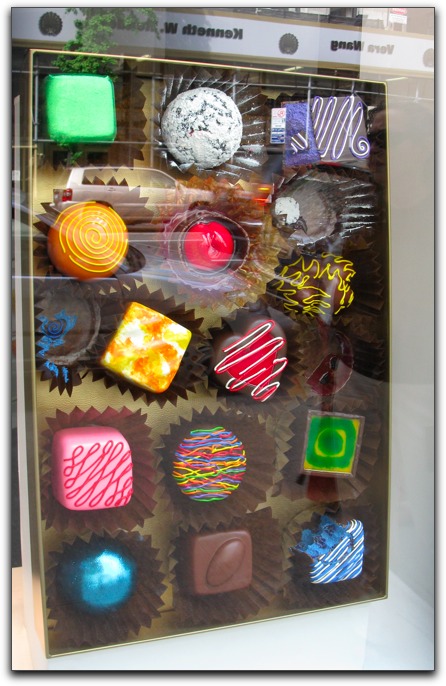
In Zurich SALIS & VERTES GMBH Bahnhofstrasse 3:
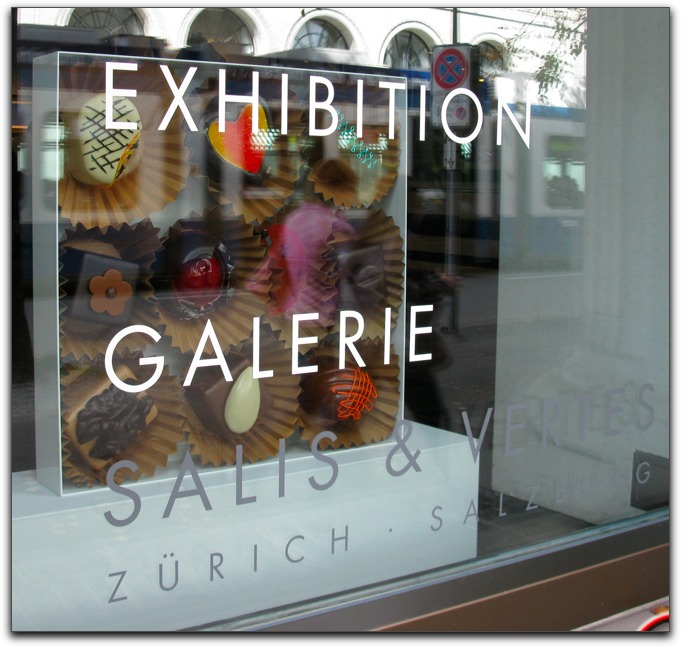
Crossing the Limmat river on the Quaibrüke where we took our portrait on the lake-view side…
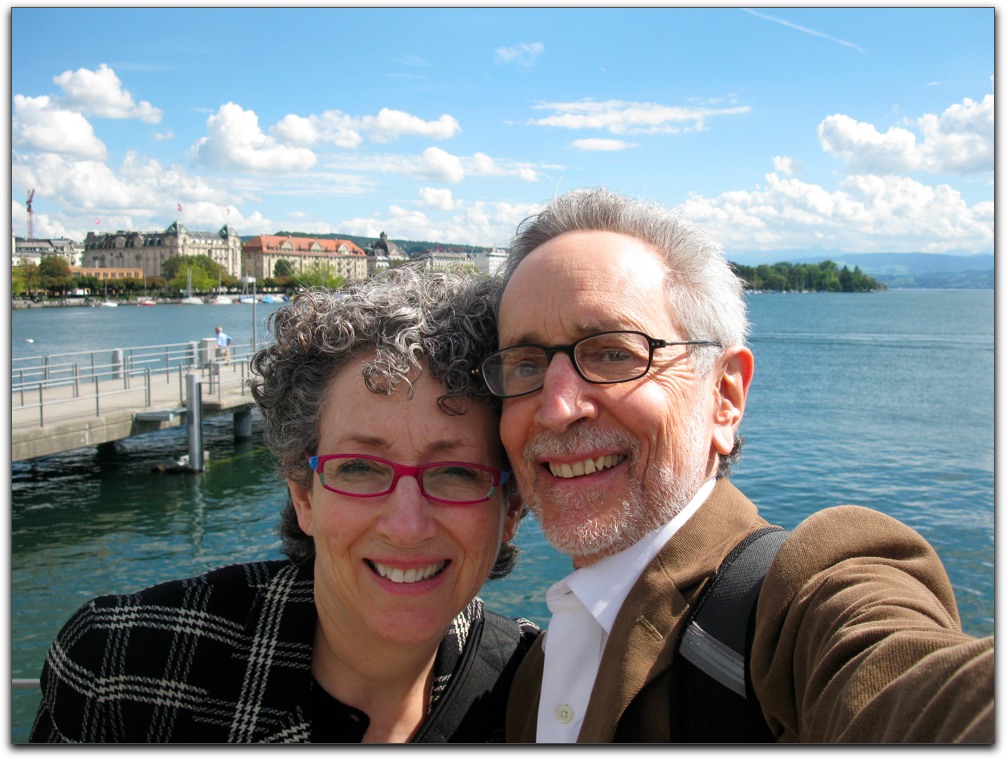
…we arrived at Bellevue Platz a few minutes before our planned meeting with Anne Cuneo.
Nisus Software and Hurvitz Travels
Mark usually keeps his Nisus work and his personal/rabbinic life separate. However, sometimes they coincide with wonderful experiences. Over the years he has had an opportunity to meet and correspond with people who write in the European languages (including those that use the Cyrillic alphabet), East Asian languages, and Middle Eastern languages. Nisus users in Germany and France were very gracious and generous hosts during our 2006 trip. [add links to earlier trip visits… check early version of document]
Anne Cuneo first started using Nisus in the early 1990s. She and Mark have corresponded ever since. When we planned our first trip to Europe in 2006, but our itinerary and her work commitments did not coincide. This time, as we planned our trip to Switzerland, Mark wrote again to Anne.
As instructed, we met Anne at the Felix café which sells Teuscher chocolates on the Bellevue Platz. However, that was simply our rendezvous spot. Based on our brief correspondence before the Switzerland trip, we had no idea what Anne had in mind:
I can show you a few chocolate highlights, even though I am not a specialist. I can show you around Zurich.
First on Anne’s itinerary for us was the Grossmünster church and the (replacement) tree beneath which Charlemagne is said to have sat to offer judgements. The idea that a tree is the location for judgements and important gatherings was not new to us. It makes a certain amount of sense to sit in the shade of a tree, and we had visited Gernika (Guernica) and the phrase “Elon Moreh” אלון מורה which literally means the “teaching oak” (but is now—to the contrary—the name of a settlement over the Green Line). Inside, most people were on the main floor, but Anne took us to the intimate crypt below where we could see remnants of earlier frescos and the original statue of Charlemagne placed for safe-keeping.
Then, we joined tourists from around the world as we walked up the old cobble-stoned narrow streets into the Old City of Zurich… with our own personal tour-guide who lives in the neighborhood. Little did we know the treats Anne had in store for us. As she had remarked, though she is not a specialist in chocolate, she knows where the chocolate is found. This one here, Schober, was owned by two sisters… (that’s Debbie and Anne outside seen through the window).
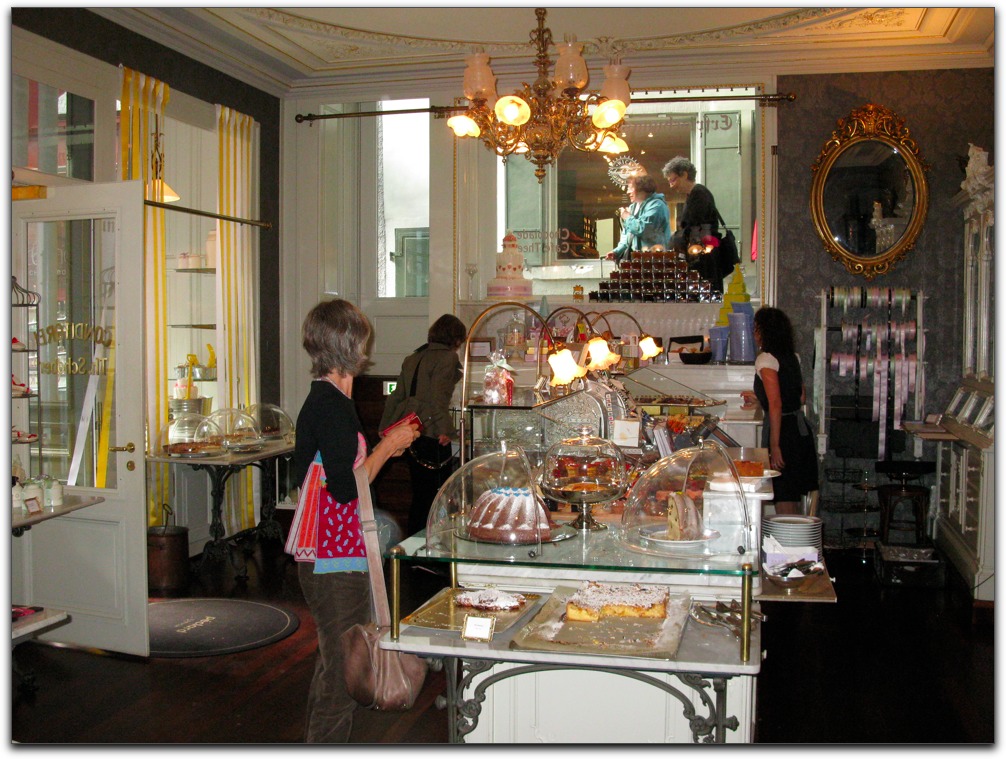
Once Anne had dealt with chocolate, she got down to the more important aspects of her tour. Our first stop was at the building where, of special interest to Anne, a journalist, Solomon Gessner had lived (and many other famous people from time to time). Gessner was the founder of the NZZ, the Neue Zürcher Zeitung one of the oldest newspapers that is still in circulation, articles from which Mark often reads translations posted at a European site called signandsight.com (let’s talk european). Nearby was a house where a number of other famous Zurichers had lived, beginning with the author Georg Büchner, whose name Mark was surprised to have recognized from a recent article in the NYTimes.
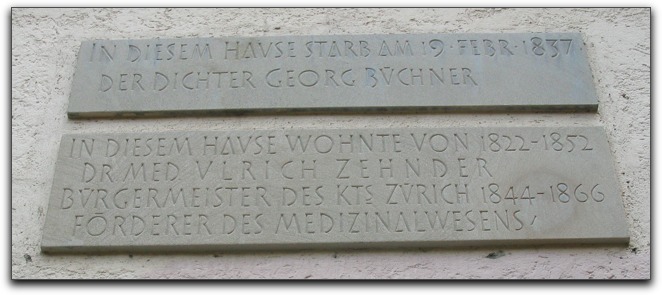
At the beginning of the 20th century, Zurich was a hotbed of political and artistic ferment. We stood at the entrance to the building at Spiegelgasse 14 where Lenin had lived. Just underneath was an intriguing store with a tiny sign advertising its presence: AHA.
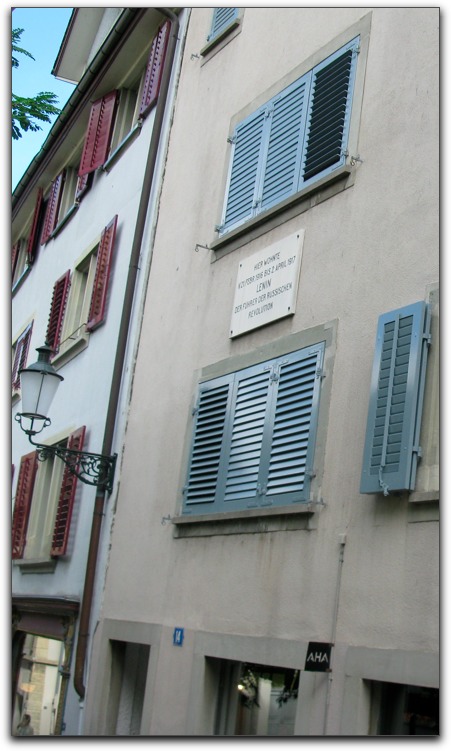
The shop is the remnant of a museum exhibit from a number of years ago filled with mathematical and geometric “toys.” We immediately thought of Loren and Luis who would have enjoyed the space. Lenin would likely have considered it a bourgeois wasteland.
A few steps further brought us to the Neumarkt and its theater home to the 1893 Congress of the Second International of the Socialist and Labor parties (and, in attendance were: August Bebel, Vladimir Lenin, Leon Trotsky, and Rosa Luxemburg the last of whom Anne told us also lived in the city for a time… probably while attending the university).
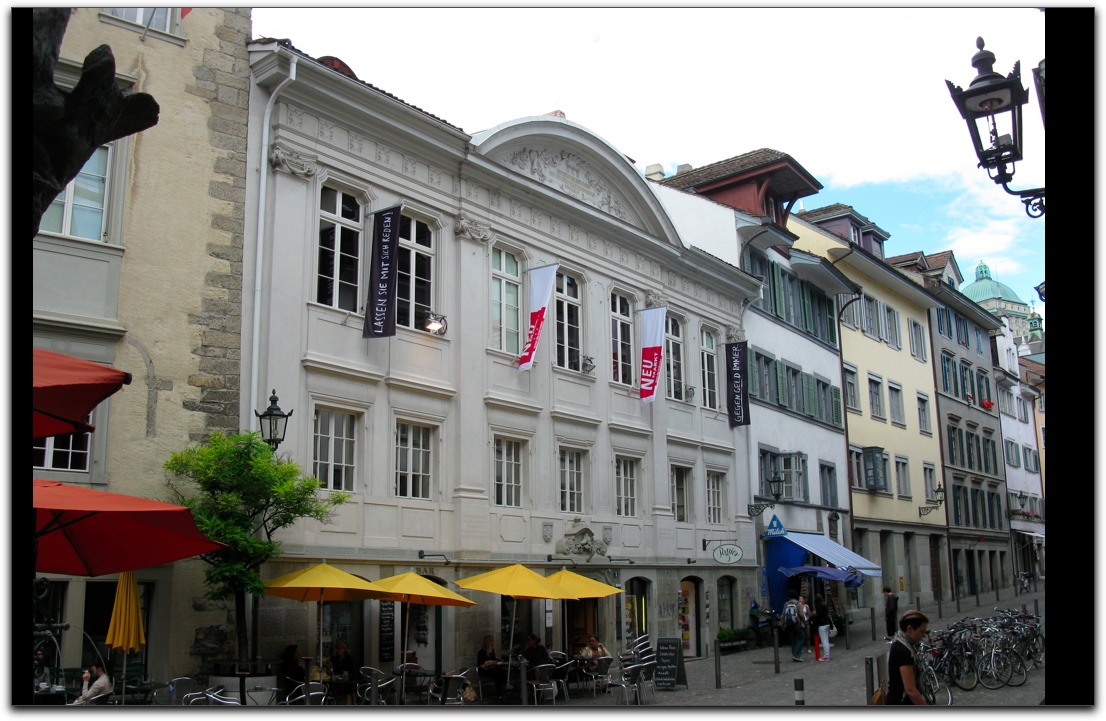
As Mark wrote this report at the end of September, he saw that a play called the “Jewess of Toledo” based on the life of Rahel la Fermosa was opening there. This particular story has had a life of its own in literature with a play written about it in German called “Die Jüdin von Toledo” in 1851. One hundred years later Leon Feuchtwanger wrote a novel with the same title. And now, 50+ years later, the play in Zurich at the Neumarkt is a reworking of the 1955 novel by Feuchtwanger. So a play that become a novel became a play. This is like the movie Nine, based on the Broadway musical Nine, which itself was based on the Fellini film 8½.
Walking a bit to the left of those yellow umbrellas brought us to a tiny walkway called the Synagogengasse:
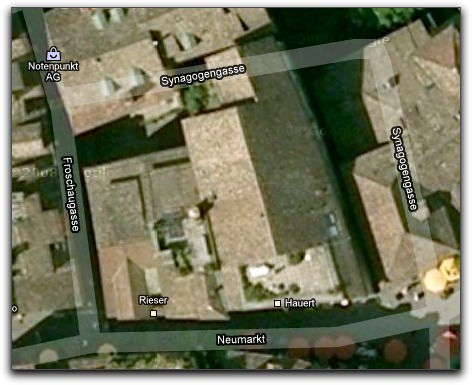
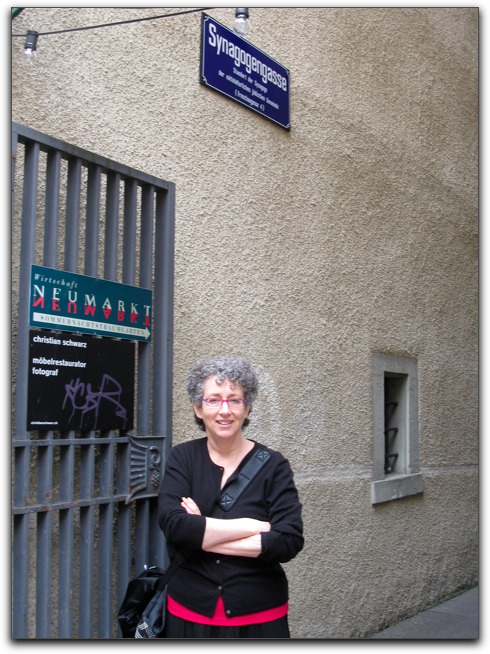
In 1349 this was the area of the Zurich ghetto. However, due to accusations related to spreading plague, the Jewish community was destroyed and the building forgotten. The building now houses a music store.
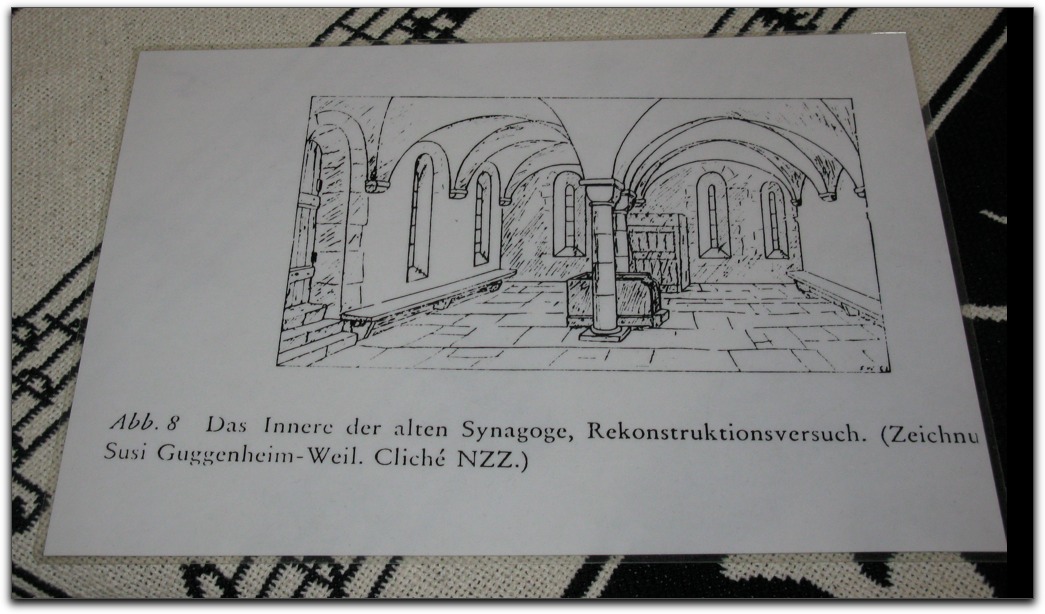
During reconstruction for the music store, the builders noticed odd medieval pre-existing structures (among them the usual clincher that this was a Jewish building… a mikvah). A commemorative plaque marks one of the corners. And therein likes a different story that Anne would share with us later about Swiss national politics.
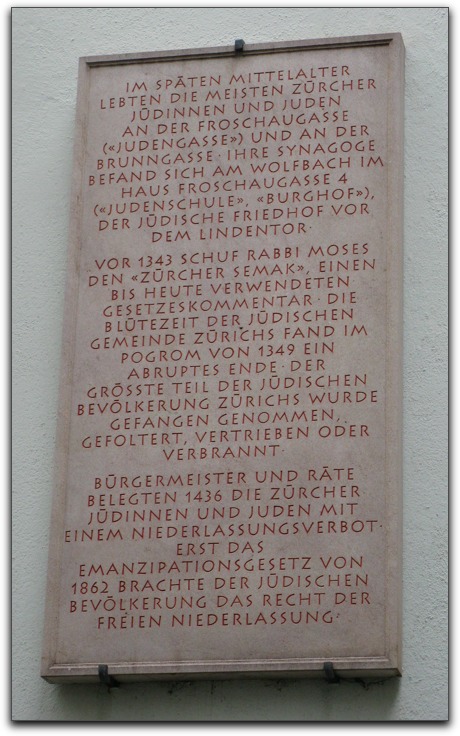
The plaque reads:
In late middle ages most of Zurich’s Jews lived at Froschaugasse (“Jewish street”) and at Brunngasse*. The synagogue was near Wolf Stream (or Brook)** at Froschaugasse 4 (“Jewish school”, “burghoff”). The Jewish cemetery was outside the Lindentor. ***
“Before 1343 Rabbi Moses wrote the Zurich SeMaK (Sefer Mitzvot haKatan), a legal gloss still in use. The golden age of the Jewish community came to an abrupt end in the Zurich Pogrom of 1349. The largest part of the Jewish population of Zurich were captured, tortured, expelled or burned.
In 1436, the mayor and the councils imposed a ban on Jews, who were prohibited to live in Zurich. It was only with the emancipation laws of 1862 that Jews acquired the right the right to choose freely where to live.
*Brunn is a given name, Brunngasse is The Street of Brunn
** This brook or stream still runs under the houses, it gives water to the whole block
*** Jews were consistently buried outside the cities. Lindentor was one of the gates of Zurich (situated where Bahnhostrasse is nowadays – it is not marked in anyway).
[translated and annotated by Anne Cuneo]
We picked up a couple of copies of a commemorative brochure published by the Hochbaudepartement der Stadt Zürich to give to Debbie’s father and our New York friend who had told us about a variety of Swiss Jewish sites.
A short walk brought us to the Cabaret Voltaire where the Dada movement began.
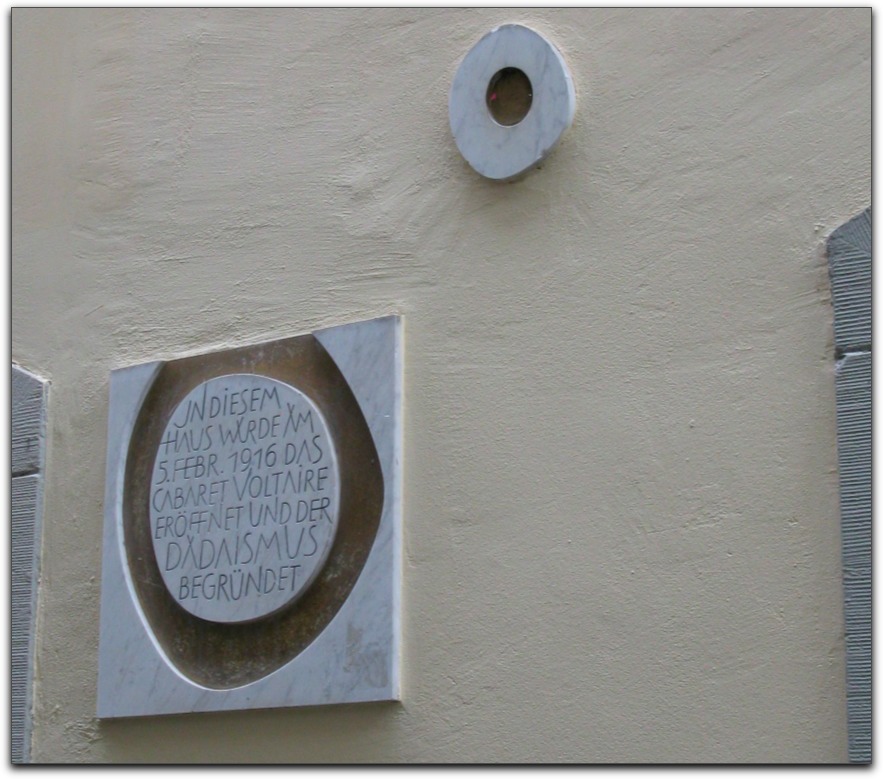
We don’t know what the café was like in 1916 when it was founded by by Hugo Ball, and Emmy Hennings with Marcel Janco, (Mark thinks he was likely in the same coffee shop with Janco in 1965 when he was on the Young Judaea Yearcourse and living at the artists colony Ein Hod.) Richard Huelsenbeck, Tristan Tzara and Jean Arp as the home of Dada. It reminded Mark of faint recollections of the Gas House which Mark’s father had taken his kids to visit in Venice Beach in the very early 1960s.
Anne led us back around to the little square in front of the Conditerei Schober to the Bodega Espanola where we sat for hours drinking Campari and tea and sampling various tapas. Anne told us the story of the election of Ruth Dreifuss to the Swiss Federal Council and how Anne realized that with such a name, she must come from a Jewish family and suggested that the journalists covering the story go to Endingen to see what they could learn. It turned out that not only was Ruth Dreifuss the first woman elected to the Council, but she was also (not intended, as there was a “Gentlemen’s agreement” that none be members) the first Jew, and later, it was learned that she was the first lesbian elected to the Council as well.
Anne shared with us some of her own life story and the novels she has written.
Debbie’s maternal grandparents visited Switzerland every summer or two. While they used to take the grandchildren on vacation with them to Santa Barbara, they never managed to take them to Switzerland. This was Debbie’s chance to see something of their Switzerland. Our initial plan included an excursion south into the mountains to visit an area called Lenzerheide. Earlier in the year Mark had been scanning old photographs of this couple and came upon some that had been identified as taken in 1930 in that area:
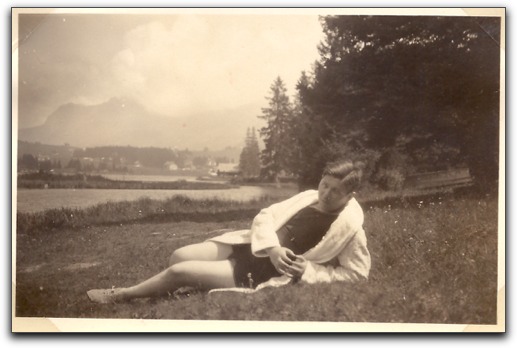
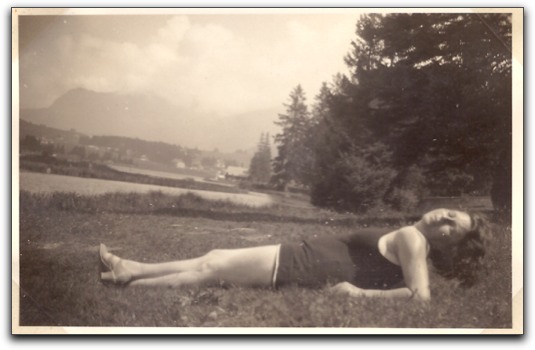
We had already visited the apartment they had lived in when they were married and we thought it would be a nice to touch base with that bit of family history as well.
Google Maps indicated that the drive was only an hour and half. But Anne thought differently. She pulled out her iPhone and checked her Swiss maps to determine that it was at least 2 hours away and, she stated emphatically that there’s nothing to see there. It’s not as idyllic as it had been 80 years earlier (being developed for tourists) and, beside that, we wanted to go in the other direction towards Basel. She encouraged a visit to Endingen instead.
Anne also took a photo of the two of us:
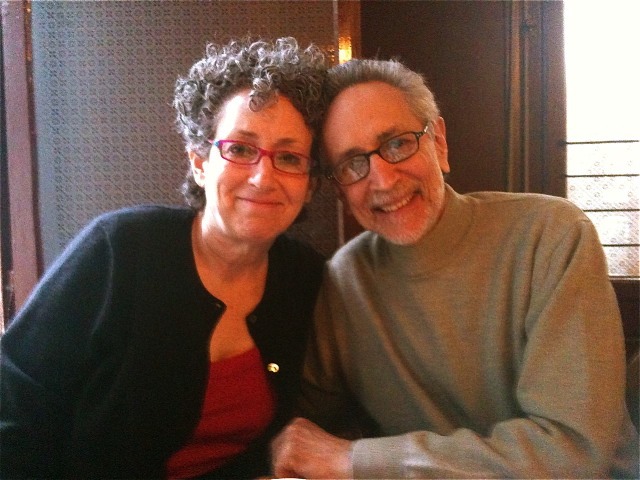
We walked back across the Münsterbrücke towards the Bahnhoffstrasse, found a Coop with a restaurant on the top floor where we ate dinner. Once you purchase your food, cafeteria style, you can sit in dining areas with set backdrops simulating a Viennese café (where we ate):
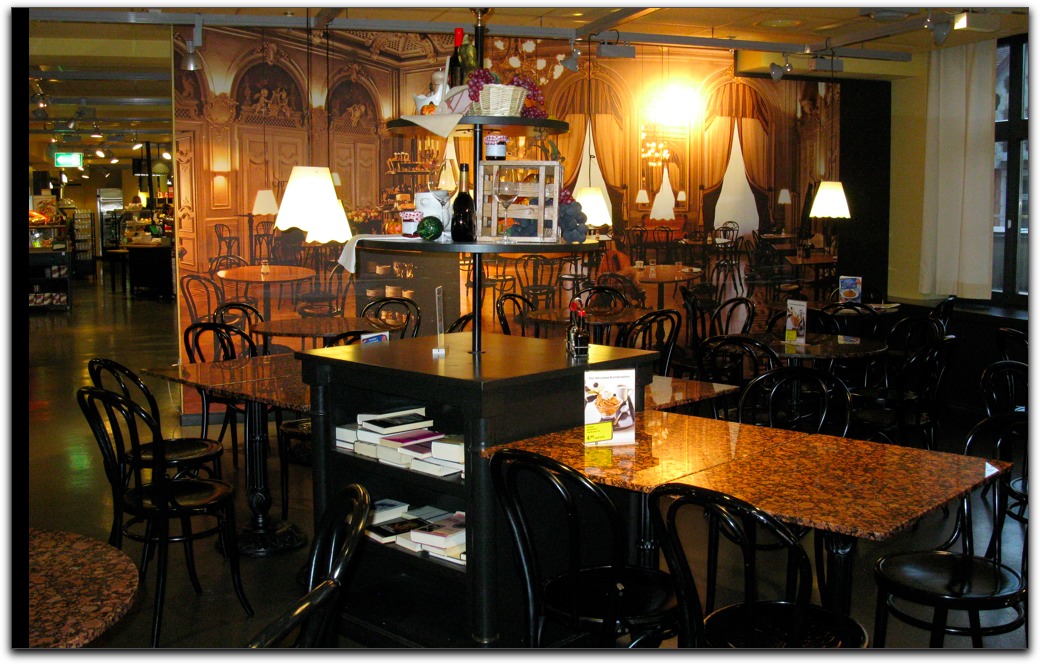
…or, around the other side of that wall, you can sit in “your own” kitchen decorated with enameled tables. We checked out the chocolate section of the Coop, wandered in and around that main shopping street explored the Merkur chocolate shop… then headed “home.”